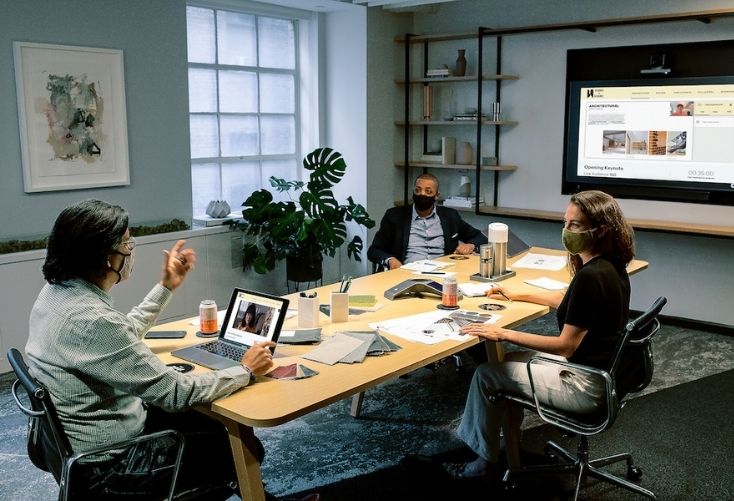Our New Reality: The Hybrid Work Day


- Convene’s Head of Workplace Solutions, Nick LiVigne, explores how the hybrid work day will shape the future of work.
- According to LiVigne, “The great remote experiment has both succeeded and failed. The hybrid work day is the answer.”
- At the center of the hybrid work experience is trust; employees choose the place where they are most productive, allowing workforces to fluidly consume workspaces.
This article was originally published on Work Design Magazine.
Workplace and people strategy trends are converging and accelerating. Trust and engagement are core to each and will require creative solutions that diverge from traditional practices.
Distributed work is being adopted to varying degrees across the business landscape. We’re also seeing a re-emphasis of the role of the office due to legitimate concerns about engagement and team productivity.
The great remote experiment has both succeeded and failed. The hybrid work day is the answer.
Outcome-based Management Drives Change
COVID-19 created a managerial stress test that revealed line-of-sight management is no longer a necessary tactic. Managers have been forced to trust their employees and measure productivity through outcomes instead of presence.
Cushman & Wakefield reported June of this year that over 90 percent of employees say their managers trust them to do their work remotely. Other surveys of leaders show reported productivity has not been meaningfully impacted. Managers had already shifted tactics or were forced to because of the pandemic, with what looks to be minimal impact to work output.
The new narrative about distributed work is being touted as employee-driven, but I’d argue that it’s more about companies accepting and codifying new ways of managing team performance.
Consider the stance taken by Siemens when announcing their work from anywhere policy: “Focus on outcomes rather than time spent in the office. Trust and empower your employees.” This is clearly a directive to managers, not employees. Acceptance among management will finally unleash the employee choice for which we’ve been arguing.
While reported productivity seems not to be impacted, there are questions about how sustainable it is to work remotely long term. Leaders are concerned that fully-remote working could lead to burnout, disengagement, and even mental health problems. Many employees also miss the social and learning aspects of time spent in an office. Striking the right balance will be important, which leads us to believe that the future is a hybrid of office-based and anywhere-based work.
Now that we’ve let the noise settle, let’s take a deep breath and remember who we are.
We are social creatures who have habitual yet dynamic styles when it comes to work. We know work to be a choppy dance of formal and informal meetings, scheduled and unscheduled coffee chats, responding to emails, Slacks, texts, and phone calls, with heads down work in between. On top of individual and group patterns, every company has a distinct culture that dictates how work is done.
This is why workplace strategy is more of an art than a science.
As the conversational pendulum swings, we will end up in a hybrid future. This hybrid future will see a significantly larger share of employee populations with access to flexibility and choice in location, and an increased emphasis on driving higher levels of employee experience and engagement through workplace design and strategy.
The hybrid work experience will center on trust. Employees will be trusted to choose the place where they are most productive, allowing workforces to fluidly consume workspaces. Companies will look to create places and strategies that build trust among their employees, allowing distributed teams to work more effectively.

Portfolio Strategies to Unlock Funding for Experience
Interacting face to face remains the best way to build trust among teams. If trust is the currency of team productivity and culture, organizations with distributed teams will need to be richer in trust than ever before. As we accept that in-person interaction will happen less frequently, we’ll need to make sure those interactions are impactful and rich in experience.
The funding for improved experience may come through organizations’ efforts to rebalance their portfolios. Real estate costs associated with their fixed assets are likely to decrease. Smart and progressive organizations will be wise to reinvest those savings into drivers of team productivity and employee experience.
The Latest News
Delivered To Your Inbox
While fixed assets will remain a core component, organizations will want to diversify their real estate portfolios by making flexible space a structural component of their strategy.
I’ve always liked the analogy of the energy grid to describe the role of flexible workspace. Utilities produce base load energy which serves to fulfill the 24/7 demand across the grid, while turning on and off more lightweight production sources to fulfill peak demand. Large organizations will apply similar logic for their fixed assets and flexible arrangements.
We’ve already seen the beginnings of a fundamental shift in the market. Companies who were already bought into a flex solution are now exploring options to expand their strategies to get even more creative with their real estate portfolios. Companies who’ve never considered flex are looking to learn about how we can help them build flexibility into their portfolios without sacrificing quality and employee experience.

Workplace Strategy to Support Hybrid Work Day
The hybrid work day will focus on engagement, collaboration, and innovation, all of which depend on high levels of trust among and between teams. We build relationships with people at work to trust they are productive members of the team. Designs will focus on teamwork over individual work and higher end experiences will be deployed to attract employees to the office.
I won’t opine on the virtues of the activity based workplace because it’s a well established strategy and has been pursued for many years by countless organizations. But, I will say that it’s now table stakes for workplace design. Gone are the days of one person, one seat assignments; space choice and flexibility must be part of any organization’s workplace strategy.
Traditional workplace design dedicated the majority of floor space to individual work settings, with formal and informal collaboration spaces making up the remainder. Expect that ratio to flip. Employees will now come into the office with a purpose to meet and engage with their team. We can imagine a future where team collaboration space is dedicated and individual space is shared. A team-first approach will force meeting room design, use, and location to be reimagined.
A particularly pressing challenge to solve for collaboration in a hybrid world will be the concept of equity in participation and experience. We’ve all experienced the challenge of being on conference calls while a group meets together in a room. Side chatter, challenging audio, lack of visuals, and the post-meeting conversations make that experience sub-par. The video-centric experience should go a long way to help, but meeting room design will need to put hybrid participation at its core, as opposed to an add-on feature.

Many organizations are also questioning the value of internally owned and operated conference and event space.
Small group collaboration spaces must be readily accessible where teams work frequently, but larger meetings and company events do not need to be held on-site and certainly not in an internally operated space that sits empty most of the year. Companies will choose on-demand meeting space to fulfill their need for higher touch experiences.
Organizations who fundamentally question the purpose of place within their culture, and commit to new creative strategies, will be in the best position to win. Those who only make incremental changes will snap back into the place they were before, losing out on new talent and progressive leaders.
Takeaways:
- Companies are now planning for a future of distributed workforces and remote team management which will require higher levels of trust than before.
- Demand for workspace is shifting in location and type. Expect higher proliferation and adoption of flexible workspace solutions.
- The future is hybrid. In-person and remote teams will need to have access to a unified workplace experience, which can be provided through creative workplace strategy solutions.
"work" - Google News
November 26, 2020 at 10:03PM
https://ift.tt/2Jb8ntf
Our New Reality: The Hybrid Work Day - AllWork.Space
"work" - Google News
https://ift.tt/3bUEaYA
Bagikan Berita Ini














0 Response to "Our New Reality: The Hybrid Work Day - AllWork.Space"
Post a Comment